Did you know that almost half the homes in the USA have mold? Since mold grows in a wet environment, it is most prevalent around showers. Without proper waterproofing, your shower walls and floor could harbor dangerous mold. This can pose a health risk while also reducing the value of your property.
Additionally, constant water seepage can compromise the structural integrity of your house. The construction industry has developed various shower waterproofing methods to counter this. This includes waterproof membranes and foam wallboards. In this guide, we will tell you how to waterproof your shower system. We will also be discussing each waterproofing method in detail.

How to Waterproof Your Shower?
There are four reliable methods for waterproofing your shower. Each method has its own benefits and disadvantages. So, choosing the right shower waterproofing method can vary depending on available space, cost, and DIY skills.
So, let us take a look at each waterproofing method in detail:
1. Sheet Membrane Shower Waterproofing
Sheet membranes are made using plastic compound blends, making them waterproof. These membranes tend to be pretty thin but can still handle a large amount of load. Additionally, you don’t have to worry about coating thickness or applying many coats.
This makes sheet membranes much quicker to install. They are also designed to allow the mortar to bond. So, you get a strong bond when installing wall tiles and floor tiles. On the downside, an overlap of the sheets is often required when using sheet membranes.
This overlap can look out of place and create an uneven surface. It can also be difficult to keep the sheet membrane wrinkle-free during installation. This waterproofing method requires more skill for installations.
You apply the sheet membrane onto the tile backer board or the shower base. You can do this using mortar. But there are also “peel-and-stick” variants that are different. You only need to use a layer of primer to attach a peel-and-stick sheet membrane.
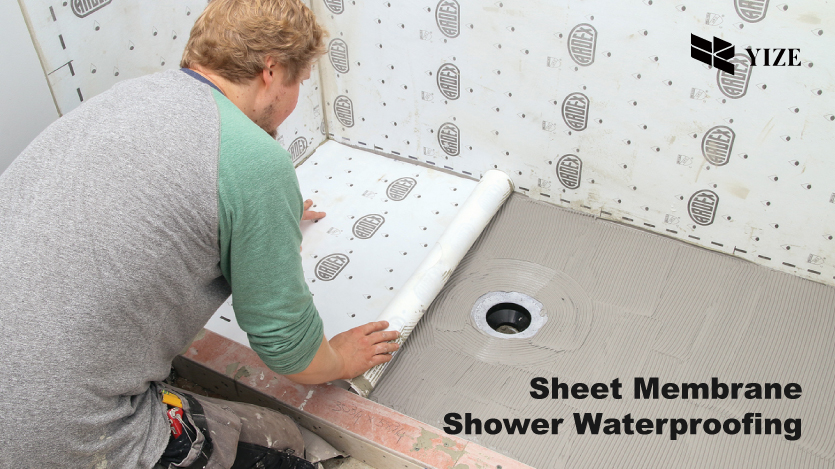
You can also find special molded sheet membrane pieces designed to go into corners. This eliminates seams and reduces overlaps, providing better waterproofing. Molded pieces designed for drains and coves are also available on the market.
This versatility in shapes and designs can be a great help for beginners. You should always remove the air bubbles underneath the sheet membrane during installation. This is because air bubbles can cause weakness in bonding.
Sheet membrane waterproofing only requires trowels, flat trowels, and a cutter. But you need to have good DIY skills to ensure good bonding and least overlaps. That is unless you are using the peel-and-stick variant, which is much easier to install. You can also use smart collars with sheet membranes to form effective seals.
2. Liquid Membranes Shower Waterproofing
Liquid membrane waterproofing work like sheet membranes. Instead of using premade sheets, you can apply liquid membranes like paint. Liquid membranes dry into a rubber-like coat after drying.
The resulting coat is flexible and durable. Some liquid membranes are also great for crack isolation. This shower waterproofing method is one of the easiest.
It is also cheap while being super effective at the same time. But this is only true if you apply the liquid membrane correctly. Liquid membrane waterproofing can take quite a while in bad weather conditions.
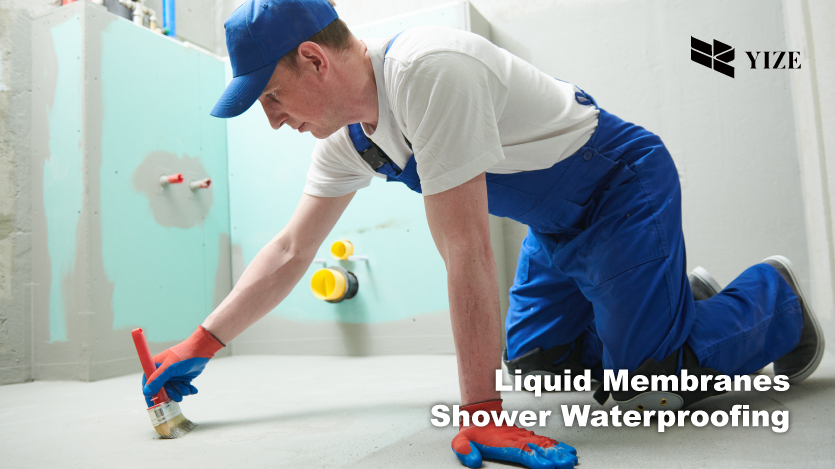
The need for many coats also means you have to wait for the previous coat to dry. In the worst weather conditions, this method takes days. If you are using a mud pan base, then the wait time can be even longer.
You may apply liquid membranes over any shower configuration using a roller. You can also find liquid spray membranes that can be sprayed on the surface instead. Applying liquid membranes is super easy, but there are some things you need to keep in mind.
The first is to get the right coat thickness. The coat thickness requirement of a liquid membrane can be found on the container’s label. You can use a wet film gauge to easily measure the thickness of a coat.
Additionally, you need to apply multiple coats. The number of coats needed can also be found on the label. Be sure to let the previous coat dry before applying the second one.
3. Foam Wallboards Shower Waterproofing
Foam wall board waterproofing is also very easy to install, requiring very little DIY skills. A foam wallboard is usually made of polystyrene foam. Since these wallboards are waterproof, you don’t need to apply membranes over them. Instead, you can use them as backer boards.
This can help cut down installation time and difficulty. Additionally, foam wallboards provide structural strength while also preventing water seepage. They are also great at bearing load, allowing the tiles to be installed directly onto them.
They also have a layer of mortar bonding material on both sides. The only downside of this waterproofing method is that it can be costly. But the light weight of foam wallboards and their effectiveness make them worth the investment.
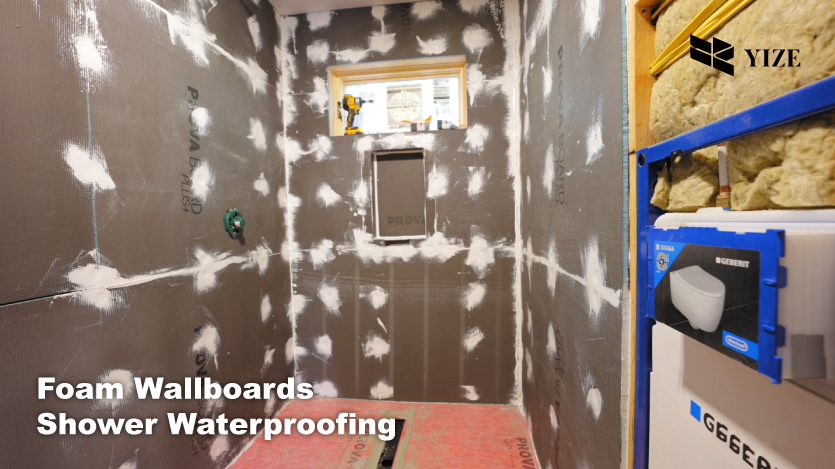
Foam wallboard waterproofing is a simple process. All you need are some fasteners, sealant, a drill, a hammer, and the right screwdriver. You can use special fasteners with washers to fasten the foam wallboard to the wall or the floor. Be sure to put a membrane or adhesive onto each fastener to prevent a leak.
You must seal the seams between the foam wallboards using a waterproof sealant. You can also apply a layer of liquid membrane on top of the seams to be extra safe. Once you’re done, the shower should be waterproof and you may tile it. If needed, you will also need to cut the foam using an electric saw.
4. Foam Shower Base Shower Waterproofing
Foam shower bases are premade bases for your shower. A great feature of this waterproofing method is that you don’t need to pre-slope your shower floor. This is because foam shower bases are already sloped for water drainage.
Foam shower bases usually come in a kit. The kit may also contain foam shower curbs, corner tape, and seam tape. It can also include a membrane-bonding shower drain.
Foam shower bases are costly, like foam wallboards. They are also made of the same material. Since they are premade, foam shower bases are easy and quick to install.
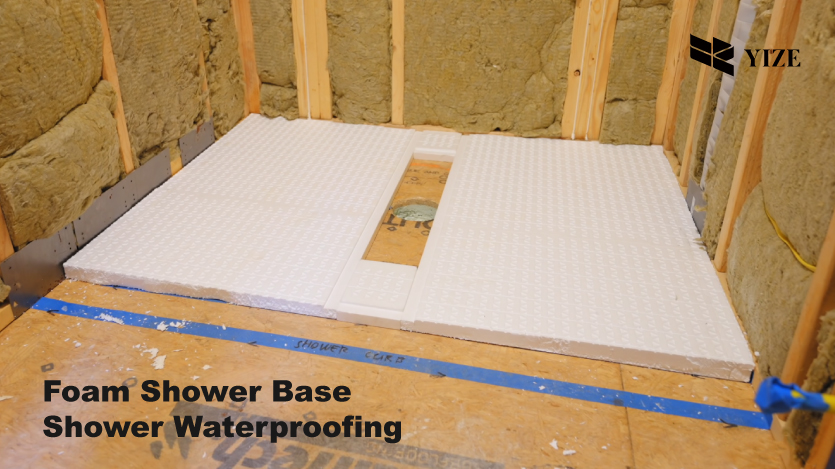
Foam shower bases come in many standard sizes to fit your shower. But if you do need to cut one to get a good fit, you can do so with a circular saw. You can install the base onto the subfloor with some mortar.
As mentioned before, the subfloor doesn’t need to be pre-sloped. You will also need to use tape on the seams and corners to cover them. Then apply a layer of waterproof adhesive over the tape to prevent drainage. Foam shower bases come with many drain orientations. So be sure to pick the orientation that best suits your shower.
Frequently Asked Questions
Now that we have discussed all there is to know about shower waterproofing methods, you may have some questions. So, here are some commonly asked questions about shower waterproofing that you will find helpful:
What is the Difference Between Water-Resistant And Waterproof Materials?
Knowing the difference between water-resistant and waterproof materials is very important. Water-resistant material is only resistant to water to some degree. So, if it is in prolonged contact with water, a leak can occur.
Waterproof material, on the other hand, is impervious to water. It can prevent water seepage and leakage. Knowing the difference between water-resistant and waterproof materials can be a lifesaver.
Is the Traditional Shower Waterproofing Method Reliable?
The traditional shower waterproofing method is being used to this day by contractors. But, it has become less popular in recent years. This is because it isn’t as effective as some other, more reliable methods.
The traditional waterproofing system depends on a rubber or copper pan liner. You place this pan liner underneath a mortar base. The idea is that the pan liner will work as a membrane, preventing water seepage.
But, there is a fatal flaw with this method. The water can still seep through as the house shifts, or the pan liner moves as the house settles. Also, sometimes the water doesn’t drain into the weep holes. This is why the traditional waterproofing shower system method is dying out today. Due to these downsides, we don’t recommend relying on this method.
What is a Vapor Barrier?
Some showers, like steam showers, generate a lot of vapors. This can cause mold growth. This kind of shower may need a vapor barrier to prevent water seepage.
So if you are going for a steam shower, you will need to pick vapor barrier materials for waterproofing. But this doesn’t mean all showers need this. In fact, normal showers don’t produce enough moisture, so normal waterproofing suffices.
How to Test Shower Waterproofing?
There are many ways to test shower waterproofing and identify leaks. The first is to do a visual inspection. But this isn’t reliable. A better alternative is to do a flood test.
To do a flood test, plug the drain hole in the shower. You can do this using a test balloon or a cap. Then, fill the shower with water to the curb. You can also put down a marked line and fill it up to the mark. Once finished with all this, you need to wait for around 24 hours.
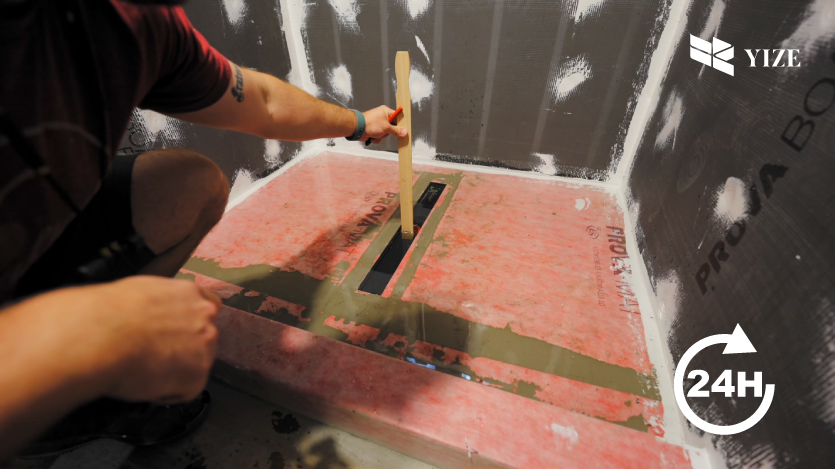
If the water level has dropped, then there is a leak somewhere in the shower. You can check for water seepage signs near the shower on the floor, walls, or the ceiling underneath. Once you have identified the leak location, fix it and do another test to be safe.
It is important to note there will be a slight drop in water level due to evaporation. This is normal. The flood test is an easy and reliable way to detect leaks.
Final Thoughts
The best shower waterproofing method can vary from situation to situation. But you should not limit yourself to the four options. You can also use hybrid builds to better waterproof your shower system.
If you intend to hire a professional, then be sure to ask for all the details. This includes the type of material and waterproofing method they intend to use. Additionally, the accessories you intend to use matter as much. This is because the accessories can act as a weak spot in the waterproofing.
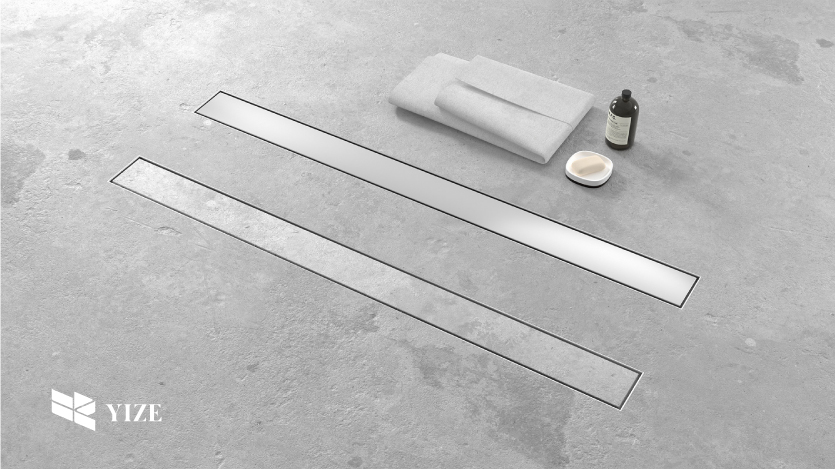
For instance, a low-quality drain can make waterproofing pointless. This is because a low-quality drain can develop a leak over time. So, we recommend the YIZE drains that come in all shapes and sizes. YIZE places a great emphasis on high quality, making their drains reliable. You can order any type of drain you want by going to our site.

